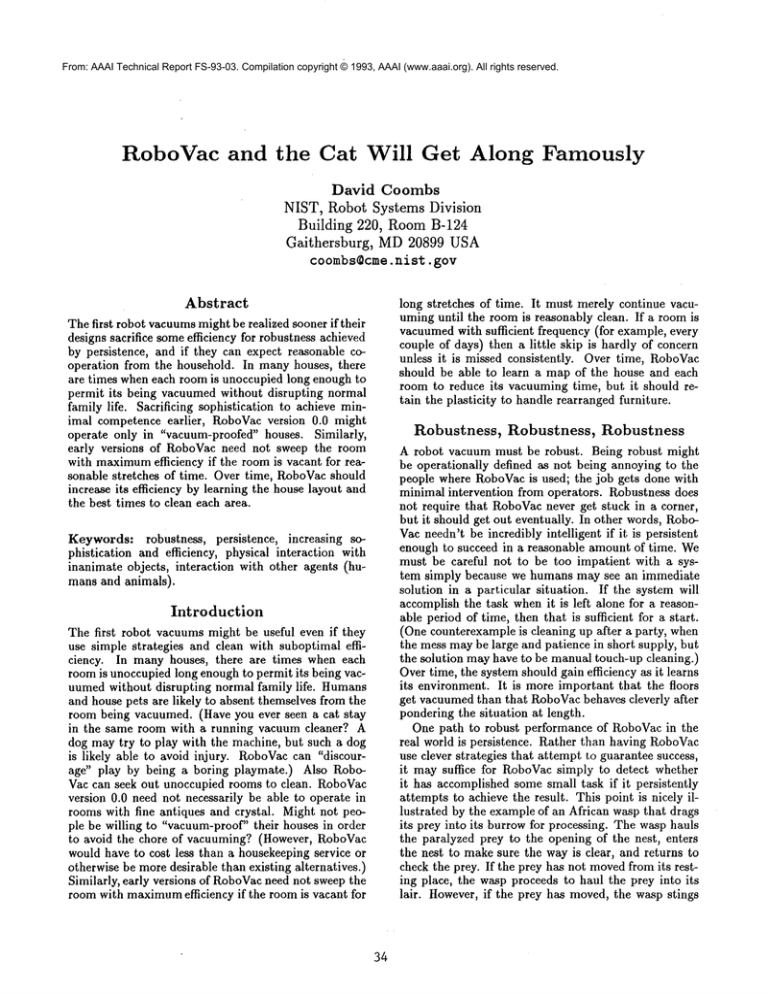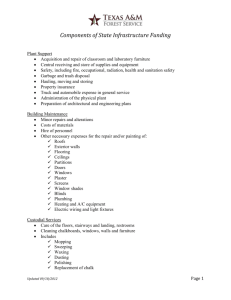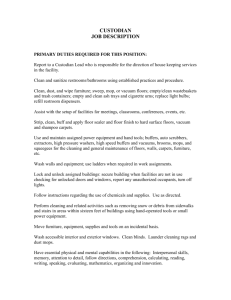
From: AAAI Technical Report FS-93-03. Compilation copyright © 1993, AAAI (www.aaai.org). All rights reserved.
RoboVac and the
Cat Will
Get Along
Famously
David Coombs
NIST, Robot Systems Division
Building 220, RoomB-124
Gaithersburg, MD20899 USA
coombs~cme, nist. gov
Abstract
long stretches of time. It must merely continue vacuuming until the room is reasonably clean. If a room is
vacuumedwith sufficient frequency (for example, every
couple of days) then a little skip is hardly of concern
unless it is missed consistently. Over time, RoboVac
should be able to learn a map of the house and each
room to reduce its vacuuming time, but it should retain the plasticity to handle rearranged furniture.
The first robot vacuumsmight be realized sooner if their
designs sacrifice someefficiency for robustness achieved
by persistence, and if they can expect reasonable cooperation from the household. In many houses, there
are times when each room is unoccupied long enough to
permit its being vacuumed without disrupting normal
family life. Sacrificing sophistication to achieve minimal competence earlier, RoboVacversion 0.0 might
operate only in "vacuum-proofed" houses. Similarly,
early versions of RoboVac need not sweep the room
with maximumefficiency if the room is vacant for reasonable stretches of time. Over time, RoboVacshould
increase its efficiency by learning the house layout and
the best times to clean each area.
Robustness,
Keywords: robustness, persistence,
increasing sophistication and efficiency, physical interaction with
inanimate objects, interaction with other agents (humans and animals).
Introduction
The first robot vacuums might be useful even if they
use simple strategies and clean with suboptimal efficiency. In many houses, there are times when each
room is unoccupied long enough to permit its being vacuumed without disrupting normal family life. Humans
and house pets are likely to absent themselves from the
room being vacuumed. (Have you ever seen a cat stay
in the same room with a running vacuum cleaner? A
dog may try to play with the machine, but such a dog
is likely able to avoid injury. RoboVaccan "discourage" play by being a boring playmate.) Also RoboVac can seek out unoccupied rooms to clean. RoboVac
version 0.0 need not necessarily be able to operate in
rooms with fine antiques and crystal. Might not people be willing to "vacuum-proof" their houses in order
to avoid the chore of vacuuming? (However, RoboVac
would have to cost less than a housekeeping service or
otherwise be more desirable than existing alternatives.)
Similarly, early versions of RoboVacneed not sweep the
room with maximum
efficiency if the room is vacant for
34
Robustness,
Robustness
A robot vacuum must be robust. Being robust might
be operationally defined as not being annoying to the
people where RoboVacis used; the job gets done with
minimal intervention from operators. Robustness does
not require that RoboVacnever get stuck in a corner,
but it should get out eventually. In other words, RoboVac needn’t be incredibly intelligent if it is persistent
enough to succeed in a reasonable amount of time. We
must be careful not to be too impatient with a system simply because we humans may see an immediate
solution in a particular situation. If the system will
accomplish the task when it is left alone for a reasonable period of time, then that is sufficient for a start.
(One counterexample is cleaning up after a party, when
the mess maybe large and patience in short supply, but
the solution may have to be manual touch-up cleaning.)
Over time, the system should gain efficiency as it learns
its environment. It is more important that the floors
get vacuumedthan that Po3boVacbehaves cleverly after
pondering the situation at length.
One path to robust performance of RoboVacin the
real world is persistence. Rather than having RoboVac
use clever strategies that attempt to guarantee success,
it may suffice for RoboVacsimply to detect whether
it has accomplished some small task if it persistently
attempts to achieve the result. This point is nicely illustrated by the example of an African wasp that drags
its prey into its burrow for processing. The wasp hauls
the paralyzed prey to the opening of the nest, enters
the nest to make sure the way is clear, and returns to
check the prey. If the prey has not movedfrom its resting place, the wasp proceeds to haul the prey into its
lair. However, if the prey has moved, the wasp stings
the prey again and repeats the drag-inspect behavior. A
malicious god could starve the wasp to death by moving
the prey every time the wasp inspects its burrow. The
wasp survives despite this feature of its behavior because its world is not excessively adversarial. Similarly,
it is sufficient in the early stages for RoboVacto accomplish a job in a suboptimal fashion by persistent simple
attempts. For instance, consider a millipede traversing
a pile of rocks by a woodland trail. The millipede apparently travels in the direction that it wants to take.
Whenit encounters a precipice, it searches to the sides
for passage. A patient observer mayfind the millipede
attempting the same impassible route several times in
several minutes. Nevertheless, the millipede’s persistence and nondeterministic behavior eventually lead it
to a navigable route. A similar approach maybe needed
to make early progress in achieving robust behavior in
RoboVac’s complicated and unpredictable world.
Simple
Strategies
Somesimple strategies may suffice to get RoboVacoperating initially, since there are somesimple constraints
that can be exploited. For instance, it is more important for R.oboVac to adequately clean open areas that
are easily negotiated than to reach into every corner.
Most traffic occurs in open areas, so most of the dirt
and matted carpet that vacuuming is intended to treat
is in areas that are easy to reach. Even if RoboVac
could handle only open areas on a daily basis, that
would be helpful since only the corners would have to
be cleaned manually. Corners could be cleaned less frequently, since they essentially only collect falling dust.
High traffic areas present a problem for an inefficient
vacuumsince they are probably traffic bottlenecks, and
yet ideally they would be cleaned daily. The problem
with cleaning high traffic areas at night is that most
vacuumsare so noisy that they would disturb sleep and
other quiet activities. The problem with cleaning these
areas during the day is that by their nature these areas
are seldom unoccupied for long periods. There are a
few obvious strategies. One approach would be for humans to signal RoboVacwhen it would be a good time
to clean high traffic areas. This is similar to starting
the dishwasher when its noise will not be disruptive.
This allows the occupants to tell RoboVacto vacuum
these areas whenthey leave the house to run errands or
work outdoors. Nevertheless, RoboVacwill undoubtedly find itself in the path of people passing through a
traffic area it is cleaning. A simple strategy for goboVac to minimize interference with humanactivities is
for it to freeze whenever someone approaches, goboVac must be small enough that people can get around
it. If RoboVacnotices frequent passage of humans it
could at least hug the wall until the activity subsides.
A simpler approach would be to add another signal to
RoboVacto tell it to keep clear of traffic areas for a
while. This would need to be used only when RoboVac
happened to be in a busy traffic area, so it could be a
35
simple "suspend" button.
Stairs are among the areas that are most heavily
trafficked and probably least often vacuumed. Stairs
present an interesting problem for vacuuming. Ideally
they would be vacuumeddaily, like other high traffic
areas, and they are difficult to vacuum. On the other
hand, stairs are traffic bottlenecks. Further, it is a significant challenge to design a machine that will climb
and descend the stairs and vacuum them even without
interference from human and animal traffic. The problem of traffic in the stairway bottleneck is similar to the
problem in other high traffic areas, but it is arguably
more severe since space is limited and people are more
likely to be poorly balanced on stairs than on flat floors.
Again, RoboVacwould have to freeze when it encounters people moving nearby. The machine might be made
small enough to permit people to step around it, but
another approach would be to design the machine such
that people could step on it to pass. In either case, it
is critical that RoboVacshould be stationary in such
situations to avoid tripping or unbalancing passersby.
Thus, early versions of RoboVacmight be forced to
omit handling stairs entirely or at least in traffic, but it
should be a high priority to tackle stairs since the gain
would be substantial.
Progressive
Sophistication
Weshould expect there to be a progression of solutions of increasing sophistication, from working only
in "vacuum-proofed" houses to "delicate" environments
that include antiques and crystal on display. The first
RoboVacwill probably not cope with toys and clothing cluttering the floor. If people want an early version of goboVac, they may have to keep their houses
especially tidy. The problem of floor clutter is a bit
tricky. The handling of moderate sized rigid objects
may yield to simple "cow-catcher" solutions. However,
small objects (e.g., snap-together building blocks, toy
soldiers) will probably be very difficult to detect and
clear away before vacuuming. Small articles of clothing
should be easy grasp and pick up, but they may be difficult to spot. Blankets and other large cloths maybe
very difficult to handle with a gripper, but perhaps a
"spatula" manipulator would enable RoboVacto move
them. Large heavy toys (e.g., tricycles) will be difficult
to handle; they mayhave to be treated like furniture.
Furniture itself presents a dilemma. Ideally RoboVac would understand how to move furniture in order
to vacuumunder it and to replace the furniture near its
initial location but offset a little to movethe feet to new
spots in the carpet. However,the necessary capabilities
would probably make RoboVac large and cumbersome.
An alternative is to use human power to move the furniture either in cooperation with RoboVacor independently. RoboVacwould have to be very sophisticated
to make effective use of a human helper who is moving furniture while RoboVaccleans. It seems better
to have the humans nudge the furniture around occa-
sionally. However, this presents no way for KoboVac
to reach the floor space beneath a piece of furniture. A
good exampleof this problemis the dining table. If children eat at the table, there are likely to be crumbs on
the floor underneath it. (Crumbs may not remain there
long if there is a dog in the house, but this suggests an
alternative solution.) Therefore it is important to clean
under the table regularly, but the chairs present obstacles. The solutions involve either moving the chairs as
a human would, or following the dog’s example, managing to reach around the chairs without moving them.
For this purpose, RoboVacmight be equipped with a
remote vacuumhead, flexible like an elephant’s trunk,
or rigid like an anteater’s snout, with a simple brush
spinning in the end to beat particles loose. This device
should also handle cleaning along walls and corners, and
it might suffice to clean near and even under large furniture like sofas and beds. In the absence of such a snout,
the cleaning could be accomplished if the chairs where
pulled away from the table after the meal so RoboVac
could moveunder the table. It seems clear that early
RoboVacversions will require furniture to be movedby
humans to allow more complete cleaning.
In addition to expecting successive versions of RoboVac to display increasing sophistication,
RoboVac
should exhibit greater efficiency as it gains familiarity
with its environment. The earliest version of RoboVac
might merely randomly traverse each room, inefficiently
covering the space over time. However, PmboVaccould
increase its efficiency over time by learning the floor
plan of the house and the layout of each room. RoboVac might collect data while it goes about its inefficient vacuuming in each room, slowly and incrementally building a map. Perhaps the map will grow only
slowly, expanding the edge of each map that seems to
be solid. Time consumingdata aggregation, fusion, and
reorganization can take place during natural quiescent
periods such as while RoboVacrecharges its batteries.
In the early days, RoboVacwill not knowthe layout of
each room, and it will have to resort to brute force or
random methods of covering the space. As RoboVac’s
map improves, it can plan its attack on each room. Understanding doorwayswill allow it to hypothesize traffic
patterns to identify areas that should be vacuumedfrequently. Similarly, the house layout can be learned over
time, connecting the rooms and understanding traffic
paths. With a clock, RoboVaccould learn what times
of day particular rooms, halls, and stairs tend to be vacant, and it could learn good and bad times to work in
particular areas by remembering when it has been encouraged to vacuum (by command)or discouraged from
vacuuming (by traffic or command)each part of the
house. A sophisticated RoboVacmight actively control its learning, interleaving exploration and "thinking" (e.g., planning newexplorations, analyzing results,
synthesizing new maps). Learning should continue perpetually, resulting in automatic recalibration over time.
This will cope with furniture being moved,additions to
36
the house, and changing patterns of room usage.
Human RoboVac
Interaction
Humanoperator intervention
should be minimal and
reasonable. For example, the operator would empty
the vacuum’s dust bag. RoboVacshould have a docking station where it can recharge its batteries autonomously, but the operator could be expected to
lead KoboVacto the docking station occasionally when
RoboVacgets confused and loses its way. Over time,
RoboVac should get confused less often. RoboVac
should expect a reasonable level of cooperation from
the occupants of the house, but it should be prepared
for some playfulness as well. If RoboVac’s response
to moving objects is freezing, it can expect people to
"tease" it, standing still when it stands still and then
moving when it resumes work. RoboVacshould also be
prepared to endure some curious probing. A dog that
would play with RoboVaccould probably be expected
to keep itself from injury. Infants present a situation
that requires more care: the best policy is probably to
shut down whenever someone is near. This would require everyone to leave RoboVacin privacy to resume
its work, but that seems a reasonable price for additional safety.
Early versions of RoboVacmight include some explicitly programmedpolicies or strategies, such as working
in rooms when they are unoccupied. As a corollary, we
might expect it to clean living areas at night and sleeping quarters during the day. In the absence of learning
capabilities, or as a bootstrap for such learning, a human might give the robot a tour of the house, naming
each room wheneverit is visited, and identi~’ing times
that might be preferable or undesirable for its cleaning. This could allow RoboVacto build a simple map
of the house. Later, if l~boVac gets too confused to
find its dock, it could display a house layout mapaad
ask a passing humanto point out its current location
and orientation. Of course, this fca~ ,.ire could offer fun
for mischievous children of all ages. An early (and possibly expensive) installation option could be to measure
the house layout and explicitly present it to RoboVac,
but this could be tedious except in tract housing developments.
Conclusion
In summary, the first robot vacuums might be realized
sooner if their designs sacrifice someefficiency for robustness achieved by persistence, and if they can expect
reasonable cooperation from the household. Conflicting
goals must be balanced, and early versions of RoboVac
might achieve minimal levels of competence earlier by
postponing tackling some hard problems such as operating in fragile surroundings. This brief analysis suggests
that constraints exist that can be exploited to bring a
simple RoboVacinto operation in the near future.





